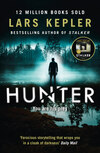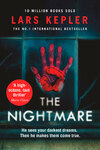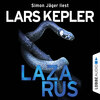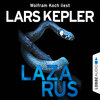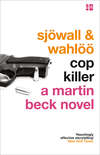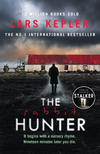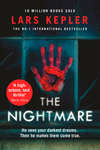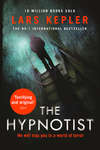Kitabı oku: «Hunter»
HUNTER
LARS KEPLER
Translated from the Swedish by Neil Smith

Copyright
This is entirely a work of fiction. Any references to real people, living or dead, real events, businesses, organizations and localities are intended only to give the fiction a sense of reality and authenticity. All names, characters and incidents are either the product of the author’s imagination or are used fictitiously, and their resemblance, if any, to real-life counterparts is entirely coincidental.
HarperCollinsPublishers
1 London Bridge Street
London SE1 9GF
Published by HarperCollinsPublishers 2018
Copyright © Lars Kepler 2016
Translation copyright © Neil Smith 2018
All rights reserved
Originally published in 2016 by Albert Bonniers Förlag, Sweden, as Kaninjägaren
Lars Kepler assert the moral right to be identified as the authors of this work
Cover design by Claire Ward © HarperCollinsPublishers 2019
Cover photographs © Mark Owen/Arcangel Images (man), David Paire/Arcangel Images (background)
A catalogue record for this book is available from the British Library
All rights reserved under International and Pan-American Copyright Conventions. By payment of the required fees, you have been granted the non-exclusive, non-transferable right to access and read the text of this e-book on-screen. No part of this text may be reproduced, transmitted, down-loaded, decompiled, reverse engineered, or stored in or introduced into any information storage and retrieval system, in any form or by any means, whether electronic or mechanical, now known or hereinafter invented, without the express written permission of HarperCollins e-books
Ebook Edition © MAY 2018 ISBN: 9780008205928
SOURCE ISBN: 9780008205904
Version: 2019-02-07
Table of Contents
Cover
Title Page
Copyright
Chapter 1
Chapter 2
Chapter 3
Chapter 4
Chapter 5
Chapter 6
Chapter 7
Chapter 8
Chapter 9
Chapter 10
Chapter 11
Chapter 12
Chapter 13
Chapter 14
Chapter 15
Chapter 16
Chapter 17
Chapter 18
Chapter 19
Chapter 20
Chapter 21
Chapter 22
Chapter 23
Chapter 24
Chapter 25
Chapter 26
Chapter 27
Chapter 28
Chapter 29
Chapter 30
Chapter 31
Chapter 32
Chapter 33
Chapter 34
Chapter 35
Chapter 36
Chapter 37
Chapter 38
Chapter 39
Chapter 40
Chapter 41
Chapter 42
Chapter 43
Chapter 44
Chapter 45
Chapter 46
Chapter 47
Chapter 48
Chapter 49
Chapter 50
Chapter 51
Chapter 52
Chapter 53
Chapter 54
Chapter 55
Chapter 56
Chapter 57
Chapter 58
Chapter 59
Chapter 60
Chapter 61
Chapter 62
Chapter 63
Chapter 64
Chapter 65
Chapter 66
Chapter 67
Chapter 68
Chapter 69
Chapter 70
Chapter 71
Chapter 72
Chapter 73
Chapter 74
Chapter 75
Chapter 76
Chapter 77
Chapter 78
Chapter 79
Chapter 80
Chapter 81
Chapter 82
Chapter 83
Chapter 84
Chapter 85
Chapter 86
Chapter 87
Chapter 88
Chapter 89
Chapter 90
Chapter 91
Chapter 92
Chapter 93
Chapter 94
Chapter 95
Chapter 96
Chapter 97
Chapter 98
Chapter 99
Chapter 100
Chapter 101
Chapter 102
Chapter 103
Chapter 104
Chapter 105
Chapter 106
Chapter 107
Chapter 108
Chapter 109
Chapter 110
Chapter 111
Chapter 112
Chapter 113
Chapter 114
Chapter 115
Epilogue
Keep Reading …
About the Author
Also by Lars Kepler
About the Publisher
It’s early morning, and the still water of the inlet is shimmering like brushed steel. The luxurious villas are asleep, but outdoor lights glint behind tall fences and hedges.
A drunk man is walking along the road by the shore, a bottle of wine in his hand. He stops in front of a white house whose elongated façade faces the water. Very carefully, he puts the bottle down in the middle of the road, steps across the ditch, and climbs the black metal railing.
The man weaves his way across the lawn, then stops and sways as he stares at the big windows, the reflections of the patio lights, the indistinct outline of the furniture inside.
He heads towards the house, waving at a large, porcelain garden gnome, and then stumbles out onto the wooden deck. He manages to hit one knee, but keeps his balance.
The water of the pool shines like a blue sheet of glass.
The man stands unsteadily on the edge, unzips his trousers and starts to urinate into the pool, then weaves his way over to the navy-blue garden furniture and proceeds to soak the cushions, chairs and round table.
Steam rises from his urine in the chill air.
He zips up his trousers and watches a white rabbit as it hops across the lawn and disappears under a bush.
Smiling, he walks back towards the house, leaning against the fence. He makes his way down to the lawn, then stops and turns around.
His befuddled brain tries to make sense of what he just saw.
A black-clad figure with a strange face was staring at him.
Either the person was standing inside the dark house, or was outside, watching him in the reflection.
1
Summer
Drizzle is falling from the dark sky. The city lights glow high above the rooftops. There’s no wind, and the illuminated drops form a misty dome that covers Djursholm.
Beside the still waters of Germaniaviken lies a sprawling villa.
Inside a young woman walks across the polished floor and Persian carpet as warily as an animal.
Her name is Sofia Stefansson.
Her anxiety makes her register tiny details about the room.
There’s a black remote control on the arm of the sofa, its battery cover taped in place. There are water rings on the table. An old plaster is stuck to the long fringe of the carpet.
The floor creaks, as if someone is creeping through the rooms behind Sofia.
There are splashes of mud from the wet stone path on her high heels and toned calves. Her legs are still muscular even though she stopped playing football two years ago.
Sofia keeps the pepper spray in her hand hidden from the man waiting for her. She keeps telling herself that she has chosen this situation. She’s in control and she wants to be here.
The man is standing by an armchair, watching her move with unabashed frankness.
Sofia’s features are symmetrical, but she has a youthful plumpness in her cheeks. She is wearing a blue dress that shows off her bare shoulders. A row of small, fabric-covered buttons stretches from her neck down between her breasts. The little gold heart on her necklace bobs up and down at the base of her throat in time with her increased heart-rate.
She could say she’s not feeling well, that she needs to go home. It would probably annoy him, but he’d accept it.
The man is looking at her with a hunger that makes her stomach flutter with fear.
She is seized by the feeling that she has met him before – could he have been a senior manager somewhere she worked, the father of a classmate a long time ago?
Sofia stops a short distance away from him, smiles, and feels the rapid beat of her heart. She’s planning to keep her distance until she’s figured out his tone and gestures.
His hands don’t look like they belong to a violent man: his nails are neatly trimmed and his plain wedding ring is scratched from years of marriage.
‘Nice house,’ she says, tucking a stray lock of hair away from her face.
‘Thanks,’ he replies.
He can’t be much more than fifty, but he still moves ponderously, like an old man in his old home.
‘You took a taxi here?’ he asks, and swallows hard.
‘Yes,’ she replies.
They fall silent again. The clock in the next room strikes twice with a brittle clang.
Some saffron-coloured pollen falls silently from a lily in a vase.
Sofia realised at an early age that she found sexually charged situations exciting. She enjoyed being appreciated, the sense of being chosen.
‘Have we met before?’ she asks.
‘I wouldn’t have forgotten something like that,’ he replies.
The man’s grey-blond hair is thin, combed back over his head. His slack face is shiny, and his brow is deeply furrowed.
‘Do you collect art?’ she asks, nodding towards the wall.
‘I’m interested in art,’ he says.
His pale eyes look at her through horn-rimmed glasses. She turns away and slides the pepper spray into her bag, then walks over to a large painting in a gilded frame.
He follows her and stands slightly too close, breathing through his nose. Sofia startles when he raises his right hand to point.
‘Nineteenth century … Carl Gustaf Hellqvist,’ he lectures. ‘He died young. He had a troubled life, full of pain. He got electric shock therapy, but he was a wonderful artist.’
‘Fascinating,’ she replies quietly.
‘I think so,’ the man says, then walks towards the dining room.
Sofia follows him even though she feels like she is being lured into a trap. It’s as if the way out is closing behind her with sluggish slowness, cutting off her escape route little by little.
The huge room is furnished with upholstered chairs and highly polished cupboards. There are rows of leaded windows looking out across the water.
She sees two glasses of red wine on the edge of the oval dining table.
‘Can I offer you a glass of wine?’ he asks, turning back towards her.
‘I’d prefer white, if you have any,’ she replies, worried that he might try to drug her.
‘Champagne?’ he says, without taking his eyes off her.
‘That would be lovely,’ she replies.
‘Then we shall have champagne,’ he declares.
When you visit the home of a complete stranger every room could be a trap, every object a weapon.
Sofia prefers hotels, because at least there’s a chance that someone would hear her if she had to call for help.
She’s following him towards the kitchen when she hears a peculiar, high-pitched sound. She can’t figure out where it’s coming from. The man doesn’t seem to have noticed it, but she stops, and turns to look at the dark windows. She’s about to say something when there’s a very distinct sound, like an ice-cube cracking in a glass.
‘Are you sure there’s no one else here?’ she asks.
She could slip her shoes off and run towards the front door if anything happened. She’s more agile than him, and if she were to run, leaving her coat hanging where it is, she’d be able to get out.
She stands in the kitchen door as he takes a bottle of Bollinger from a wine fridge. He opens it and fills two slender glasses, waits for the bubbles to settle and then tops them up before walking over to her.
2
Sofia sips the champagne. She lets the taste spread through her mouth, hears the bubbles burst in the glass. Something makes her look over towards the windows again. A deer, maybe, she thinks. It’s dark outside. In the reflection she can see the sharp outline of the kitchen and the man’s back.
The man raises his glass again and drinks. His hand is shaking ever so slightly as he gestures towards her.
‘Unbutton your dress a little,’ he says weakly.
Sofia empties her glass, sees the mark of her lipstick on the rim, and puts it down on the table before gently teasing the top button open.
‘You’re wearing a bra,’ he says.
‘Yes,’ she replies, and undoes the second button.
‘What size?’
‘Sixty C.’
The man stays where he is and watches her with a smile, and Sofia feels her armpits prickle as she starts to sweat.
‘What panties are you wearing?’
‘Pale blue, silk.’
‘Can I see?’
She hesitates, and he notices.
‘Sorry,’ he says quickly. ‘Am I being too direct? Is that it?’
‘We should probably handle payment first,’ she says, trying to sound simultaneously firm and casual.
‘I understand,’ he says tersely.
‘It’s best to get it out of the—’
‘You’ll get your money,’ he interrupts with a hint of irritation in his voice.
When she sees her regulars things are usually very straightforward – pleasant, even – but new clients always make her nervous. She worries about things she’s experienced in the past, like the father of two in Täby who bit her on the neck and locked her in his garage.
She advertises on Pink Pages and Stockholmgirls. Almost all the people who contact her are a waste of time. Lots of crude language, promises of wonderful sex, threats of violence and punishment.
She always trusts her gut instinct when she starts to correspond with someone new. This particular message was well-written. It was fairly direct, but not disrespectful. He said his name was Wille, his phone number was blocked, and he lived in a nice area.
In his third email he explained what he wanted to do to her, and how much he was willing to pay.
She took that as a warning.
If it sounds too good to be true, then there’s something wrong. There are no free meal-tickets in this world, and it’s better to miss out on a generous deal than put yourself in danger.
Still, she’s here now.
The man returns and hands her an envelope. She counts the money quickly and puts it in her bag.
‘Is that enough for you to show me your underwear?’ he says.
She smiles warmly, gently takes hold of both sides of her dress and slowly lifts it above her knees. The hem rubs against her nylon tights. She pauses and looks at him.
He doesn’t meet her gaze, just stares down between her legs as she gradually raises the dress to her waist. Her silk underwear shimmers like mother-of-pearl beneath her pale tights.
‘Are you shaved?’ he asks in a slightly hoarser voice.
‘Waxed.’
‘Completely?’
‘Yes,’ she replies.
‘That must hurt?’ he says, sounding genuinely interested.
‘You get used to it,’ she says with a nod.
‘Like a lot of things in life,’ he whispers.
She lets her dress drop again and takes the opportunity to wipe the sweat from her palms as she smooths the fabric over her thighs.
Even though she has the money she’s starting to feel nervous again.
Possibly because he paid so much, five times more than any previous client.
In one of his emails he explained that he was prepared to pay extra for her discretion, and for his specific wishes, but this is way above her normal rate.
When he wrote to tell her what he wanted to do, she didn’t think it sounded that bad.
She remembers one man with worried eyes who dressed up in his mother’s underwear and wanted her to kick him in the crotch. He paid for her to pee on him as he lay on the floor crying in pain, but she couldn’t do it. She just grabbed the money and ran.
‘People get turned on by all sorts of things,’ Wille says with an embarrassed smile. ‘Obviously you can’t force anyone … I mean, you have to pay for some things. I’m not expecting you to actually enjoy what you do.’
‘It depends, but I do sometimes enjoy it if the man’s gentle,’ she lies.
Naturally Sofia promises full discretion in her ad, but she still has one safety measure as a precaution. She keeps a diary at home, where she makes a note of the names and addresses of people she’s arranged to meet, so that someone will be able to find her if she ever goes missing.
Besides, Tamara saw Wille once, just before she stopped working as an escort, got married and moved to Gothenburg. Sofia knows that Tamara would have posted a warning on the sex-workers’ forum if he’d behaved inappropriately.
‘As long as you don’t find me revolting and repulsive,’ the man says, taking a step closer to her. ‘I mean, you’re so beautiful, and I’m … well, I know what I look like. I was OK when I was your age, but …’
‘You look good now,’ she assures him.
Sofia thinks of all the times she’s heard people say that escorts have to be like psychologists, but most of the men she sees never say anything personal.
‘Shall we go up to the bedroom?’ Wille asks lightly.
3
Sofia follows him up the broad wooden staircase thinking about how badly she needs to pee. The soft carpet is held in place on each step by thin brass rods. The light from the large chandelier reflects off the varnished banister.
Sofia’s initial plan had been to concentrate on exclusive clients, the ones who were prepared to pay more for an entire night, ones who wanted company at a party or on a trip.
In the three years she’s been working as an escort she’s had maybe a couple of dozen jobs like that, but most of her clients just want a blow-job after work before they go home to their families.
The master bedroom is well-lit, dominated by an imposing double bed with beautiful grey silk sheets.
On the wife’s side there’s a Lena Andersson novel and a jar of fancy hand cream, and on Wille’s side there’s an iPad with finger-marks on the dark glass.
He shows her the black leather straps he’s already tied around the bedposts. She notes that they’re not new, the creases are slightly cracked and the colour has begun to flake off.
The room suddenly shudders and spins around a couple of times. She looks at the man, but he seems unconcerned.
He has white marks at the corners of his mouth, from toothpaste.
The staircase creaks and he glances towards the hallway before looking back at her.
‘I have to be able to trust you to release me when I say so,’ he says as he unbuttons his shirt. ‘I have to be sure that you won’t try to rob me or just run off now that you have your money.’
‘Of course,’ she replies.
His chest is covered with fair hair, and he’s making an effort to suck in his stomach while she looks at him.
Sofia thinks that she can ask to go to the bathroom once he’s tied up. There’s an en-suite. The door is open and she can see the shower and a patch of gold mosaic wall in the mirror.
‘I want you to tie me up, and take your time with it – I don’t like violence or force,’ he says.
Sofia nods and takes her shoes off. She feels dizzy again as she straightens up. She looks him in the eye before lifting her dress up to her navel. It crackles with static. She slips her thumbs beneath the top of her tights and starts to pull them down. The feeling of constriction eases as the thin fabric puddles around her calves.
‘Perhaps you’d rather be tied up instead?’ he asks, smiling at his suggestion.
‘No, thanks,’ she replies as she starts to unbutton her dress.
‘It’s actually pretty comfortable,’ he jokes, tugging gently at one of the straps.
‘I don’t do that sort of thing,’ she explains breezily.
‘I’ve never tried it the other way around … I’d be prepared to double your fee if you did it,’ he says with a laugh, as if the thought surprises and delights him.
What he’s now offering is more money than she earns in two months, but having to lie there tied up is much too dangerous.
‘What do you say?’ he smiles.
‘No,’ she replies.
‘OK,’ he says quickly, and lets go of the strap.
The buckle makes a tinkling sound as it hits the bedpost.
‘Do you want me to take all of my clothes off?’
‘Wait a while,’ he replies, giving her an oddly searching look.
‘Is it OK if I use the bathroom?’
‘Soon,’ he says. He sounds like he’s trying to control his breathing.
Sofia’s lips feel strangely cool. When she raises one hand to her mouth she sees his face break into a wide smile.
He walks over to her, takes hold of her chin tightly, and then spits straight in her face.
‘What are you doing?’ she asks, as a rush of giddiness sweeps through her head.
Her legs suddenly give out and she lands so heavily on the floor that she bites her tongue. She sinks onto her side as her mouth fills with blood, and she sees him standing over her, unbuttoning his corduroy trousers.
Sofia doesn’t have the strength to crawl away. She rests her cheek on the floor and sees a dead fly in the dust under the bed. Her heart is beating so hard that she can hear it thudding in her ears. She realises that she must have been drugged.
‘Don’t. Don’t do it,’ she gasps, before closing her eyes.
Before Sofia loses consciousness it occurs to her that he might be about to murder her, and that this might be the last thing she ever experiences.
